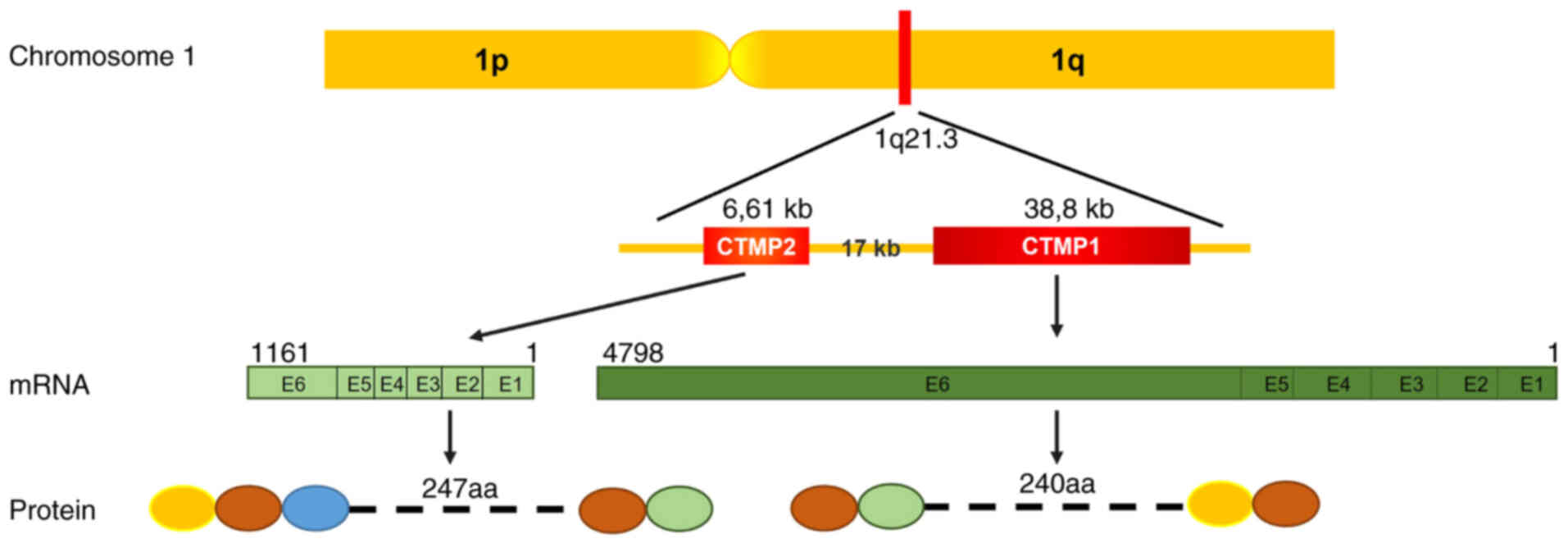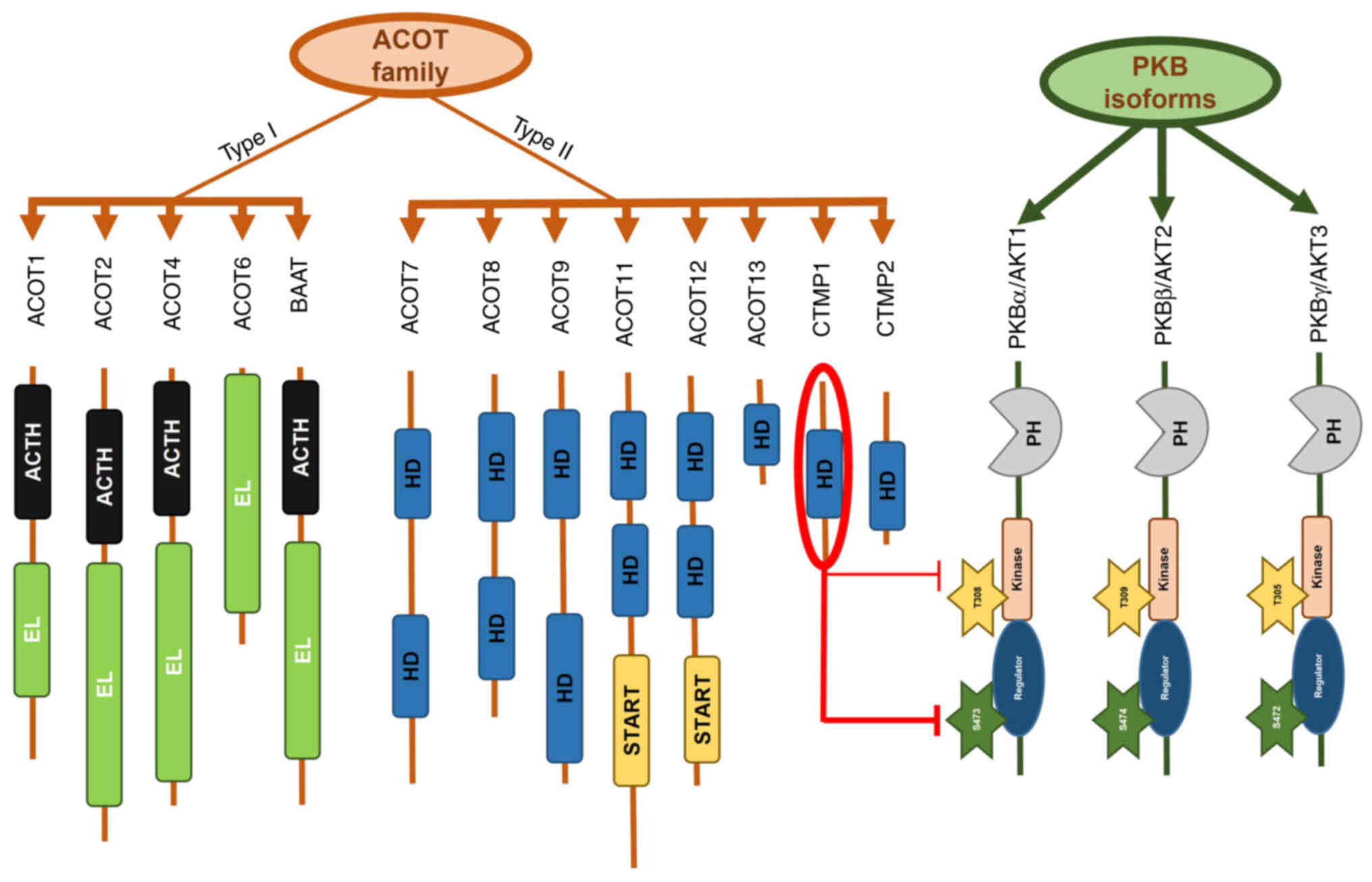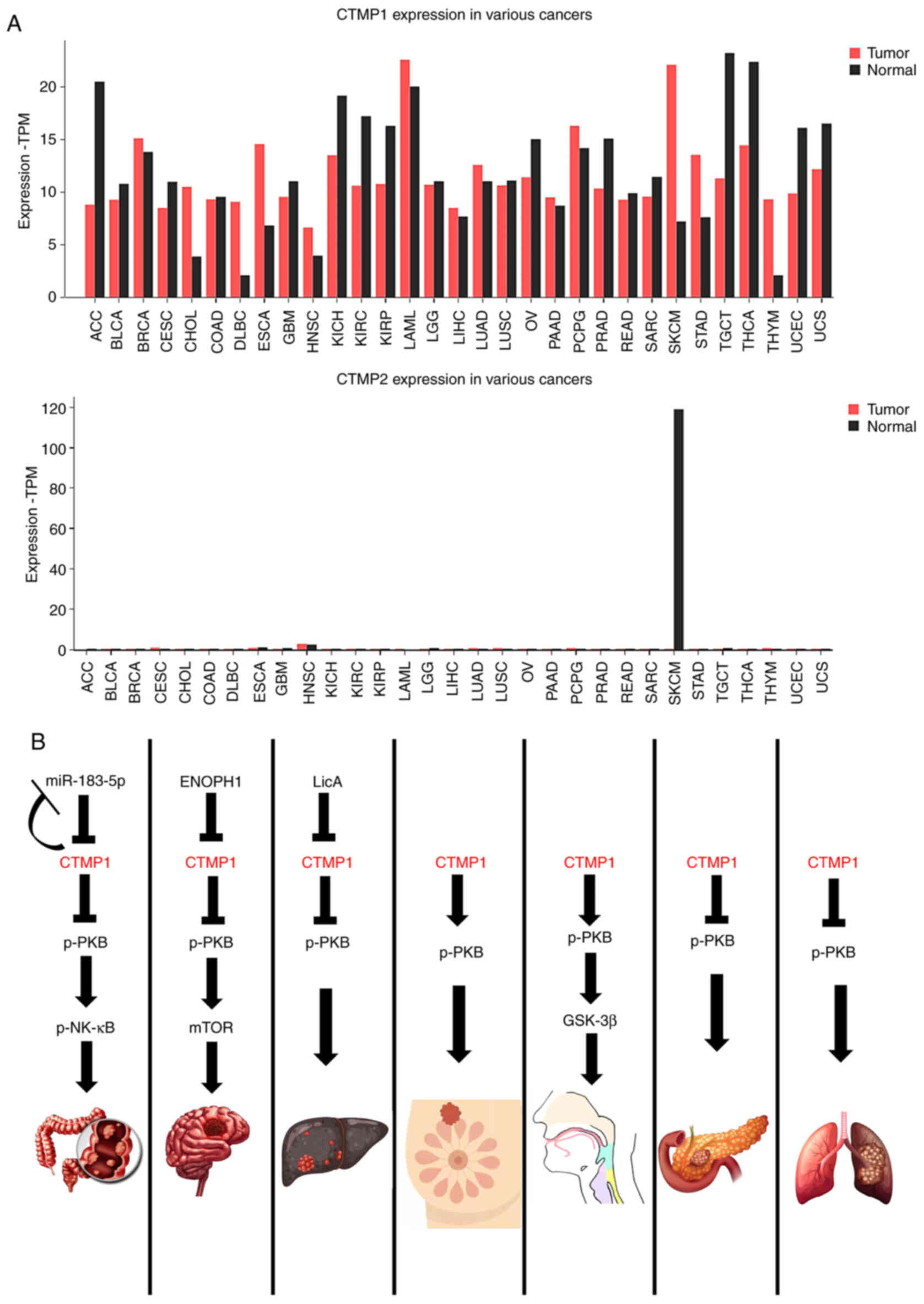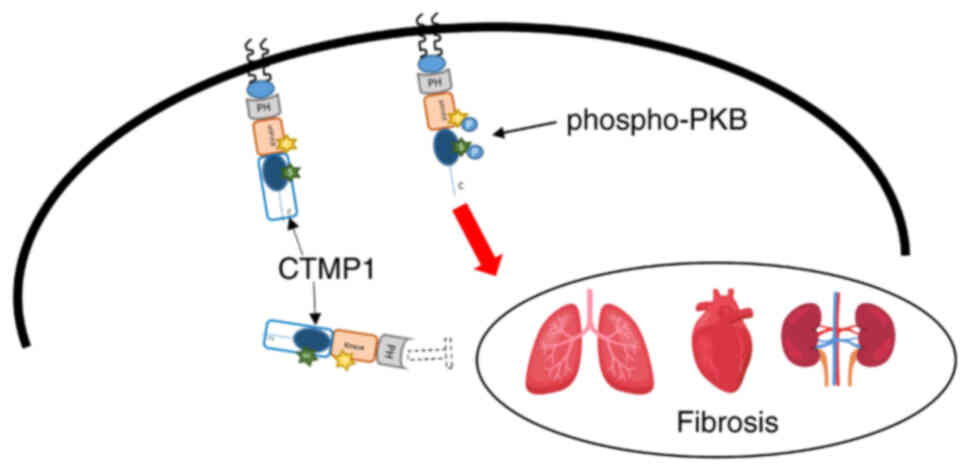Overview of carboxyl‑terminal modulator protein 1 and its importance in various metabolic regulations (Review)
- Authors:
- Huonggiang Nguyen
- Seon-Hwan Kim
- Uijin Juang
- Suhwan Gwon
- Woohyeong Jung
- Qingzhi Huang
- Soohyeon Lee
- Beomwoo Lee
- So Hee Kwon
- Jongsun Park
-
Affiliations: Department of Pharmacology, College of Medicine, Chungnam National University, Daejeon 35015, Republic of Korea, Department of Neurosurgery, Institute for Cancer Research, College of Medicine, Chungnam National University, Daejeon 35015, Republic of Korea, College of Pharmacy, Yonsei Institute of Pharmaceutical Sciences, Yonsei University, Incheon 21983, Republic of Korea - Published online on: July 5, 2024 https://doi.org/10.3892/mmr.2024.13282
- Article Number: 158
-
Copyright: © Nguyen et al. This is an open access article distributed under the terms of Creative Commons Attribution License.
This article is mentioned in:
Abstract
 |
 |
 |
 |
|
Maira SM, Galetic I, Brazil DP, Kaech S, Ingley E, Thelen M and Hemmings BA: Carboxyl-terminal modulator protein (CTMP), a negative regulator of PKB/Akt and v-Akt at the plasma membrane. Science. 294:374–380. 2001. View Article : Google Scholar : PubMed/NCBI | |
|
Manning BD and Toker A: AKT/PKB signaling: Navigating the network. Cell. 169:381–405. 2017. View Article : Google Scholar : PubMed/NCBI | |
|
Glaviano A, Foo ASC, Lam HY, Yap KCH, Jacot W, Jones RH, Eng H, Nair MG, Makvandi P, Geoerger B, et al: PI3K/AKT/mTOR signaling transduction pathway and targeted therapies in cancer. Mol Cancer. 22:1382023. View Article : Google Scholar : PubMed/NCBI | |
|
Wang Z: Regulation of cell cycle progression by growth factor-induced cell signaling. Cells. 10:33272021. View Article : Google Scholar : PubMed/NCBI | |
|
Parcellier A, Tintignac LA, Zhuravleva E, Cron P, Schenk S, Bozulic L and Hemmings BA: Carboxy-terminal modulator protein (CTMP) is a mitochondrial protein that sensitizes cells to apoptosis. Cell Signal. 21:639–650. 2009. View Article : Google Scholar : PubMed/NCBI | |
|
Piao L, Li Y, Yang KJ, Park KA, Byun HS, Won M, Hong J, Kim JL, Kweon GR, Hur GM, et al: Heat shock protein 70-mediated sensitization of cells to apoptosis by carboxyl-terminal modulator protein. BMC Cell Biol. 10:532009. View Article : Google Scholar : PubMed/NCBI | |
|
Jin H, Xu CX, Lim HT, Park SJ, Shin JY, Chung YS, Park SC, Chang SH, Youn HJ, Lee KH, et al: High dietary inorganic phosphate increases lung tumorigenesis and alters Akt signaling. Am J Respir Crit Care Med. 179:59–68. 2009. View Article : Google Scholar : PubMed/NCBI | |
|
Hwang SK, Kwon JT, Park SJ, Chang SH, Lee ES, Chung YS, Beck GR Jr, Lee KH, Piao L, Park J and Cho MH: Lentivirus-mediated carboxyl-terminal modulator protein gene transfection via aerosol in lungs of K-ras null mice. Gene Ther. 14:1721–1730. 2007. View Article : Google Scholar : PubMed/NCBI | |
|
Niu F, Duan Y, Man Y, Liu W, Dai T, Zhang H, Li C and Wei D: Mitochondrial protein LETM1 and its-mediated CTMP are potential therapeutic targets for endometrial cancer. Anticancer Drugs. 33:632–641. 2022. View Article : Google Scholar : PubMed/NCBI | |
|
Simon PO Jr, McDunn JE, Kashiwagi H, Chang K, Goedegebuure PS, Hotchkiss RS and Hawkins WG: Targeting AKT with the proapoptotic peptide, TAT-CTMP: A novel strategy for the treatment of human pancreatic adenocarcinoma. Int J Cancer. 125:942–951. 2009. View Article : Google Scholar : PubMed/NCBI | |
|
Knobbe CB, Reifenberger J, Blaschke B and Reifenberger G: Hypermethylation and transcriptional downregulation of the carboxyl-terminal modulator protein gene in glioblastomas. J Natl Cancer Inst. 96:483–486. 2004. View Article : Google Scholar : PubMed/NCBI | |
|
Chang JW, Jung SN, Kim JH, Shim GA, Park HS, Liu L, Kim JM, Park J and Koo BS: Carboxyl-terminal modulator protein positively acts as an oncogenic driver in head and neck squamous cell carcinoma via regulating Akt phosphorylation. Sci Rep. 6:285032016. View Article : Google Scholar : PubMed/NCBI | |
|
Liu YP, Liao WC, Ger LP, Chen JC, Hsu TI, Lee YC, Chang HT, Chen YC, Jan YH, Lee KH, et al: Carboxyl-terminal modulator protein positively regulates Akt phosphorylation and acts as an oncogenic driver in breast cancer. Cancer Res. 73:6194–6205. 2013. View Article : Google Scholar : PubMed/NCBI | |
|
Lin CH, Lin WD, Huang YC, Chen YC, Loh ZJ, Ger LP, Lin FC, Li HY, Cheng HC, Lee KH, et al: Carboxyl-terminal modulator protein facilitates tumor metastasis in triple-negative breast cancer. Cancer Gene Ther. 30:404–413. 2023.PubMed/NCBI | |
|
Bolze PA, Lopez J, Allias F, Hajri T, Patrier S, Devouassoux-Shisheboran M, Massardier J, You B, Golfier F and Mallet F: Transcriptomic and immunohistochemical approaches identify HLA-G as a predictive biomarker of gestational choriocarcinoma resistance to monochemotherapy. Gynecol Oncol. 158:785–793. 2020. View Article : Google Scholar : PubMed/NCBI | |
|
Ni FB, Lin Z, Fan XH, Shi KQ, Ao JY, Wang XD and Chen RC: A novel genomic-clinicopathologic nomogram to improve prognosis prediction of hepatocellular carcinoma. Clin Chim Acta. 504:88–97. 2020. View Article : Google Scholar : PubMed/NCBI | |
|
Zhang S, Li D, Zhao M, Yang F, Sang C, Yan C, Wang Z and Li Y: Exosomal miR-183-5p shuttled by M2 polarized tumor-associated macrophage promotes the development of colon cancer via targeting THEM4 mediated PI3K/AKT and NF-κB pathways. Front Oncol. 11:6726842021. View Article : Google Scholar : PubMed/NCBI | |
|
Chen YC, Li HY, Liang JL, Ger LP, Chang HT, Hsiao M, Calkins MJ, Cheng HC, Chuang JH and Lu PJ: CTMP, a predictive biomarker for trastuzumab resistance in HER2-enriched breast cancer patient. Oncotarget. 8:29699–29710. 2017. View Article : Google Scholar : PubMed/NCBI | |
|
Block M, Grundker C, Fister S, Kubin J, Wilkens L, Mueller MD, Hemmerlein B, Emons G and Günthert AR: Inhibition of the AKT/mTOR and erbB pathways by gefitinib, perifosine and analogs of gonadotropin-releasing hormone I and II to overcome tamoxifen resistance in breast cancer cells. Int J Oncol. 41:1845–1854. 2012. View Article : Google Scholar : PubMed/NCBI | |
|
Li J, Shan W and Zuo Z: Age-related upregulation of carboxyl terminal modulator protein contributes to the decreased brain ischemic tolerance in older rats. Mol Neurobiol. 55:6145–6154. 2018. View Article : Google Scholar : PubMed/NCBI | |
|
Chen Y, Nie H, Tian L, Tong L, Deng J, Zhang Y, Dong H and Xiong L: Sevoflurane preconditioning-induced neuroprotection is associated with Akt activation via carboxy-terminal modulator protein inhibition. Br J Anaesth. 114:327–335. 2015. View Article : Google Scholar : PubMed/NCBI | |
|
Kao MH, Huang CY, Cheung WM, Yan YT, Chen JJ, Ho YS, Hsu CY and Lin TN: Activating transcription factor 3 diminishes ischemic cerebral infarct and behavioral deficit by downregulating carboxyl-terminal modulator protein. Int J Mol Sci. 24:23062023. View Article : Google Scholar : PubMed/NCBI | |
|
Huang CY, Chen JJ, Wu JS, Tsai HD, Lin H, Yan YT, Hsu CY, Ho YS and Lin TN: Novel link of anti-apoptotic ATF3 with pro-apoptotic CTMP in the ischemic brain. Mol Neurobiol. 51:543–557. 2015. View Article : Google Scholar : PubMed/NCBI | |
|
Zhao S, Fu J, Liu F, Rastogi R, Zhang J and Zhao Y: Small interfering RNA directed against CTMP reduces acute traumatic brain injury in a mouse model by activating Akt. Neurol Res. 36:483–490. 2014. View Article : Google Scholar : PubMed/NCBI | |
|
Chen Y, Cai M, Deng J, Tian L, Wang S, Tong L, Dong H and Xiong L: Elevated expression of carboxy-terminal modulator protein (CTMP) aggravates brain ischemic injury in diabetic db/db Mice. Neurochem Res. 41:2179–2189. 2016. View Article : Google Scholar : PubMed/NCBI | |
|
Miyawaki T, Ofengeim D, Noh KM, Latuszek-Barrantes A, Hemmings BA, Follenzi A and Zukin RS: The endogenous inhibitor of Akt, CTMP, is critical to ischemia-induced neuronal death. Nat Neurosci. 12:618–626. 2009. View Article : Google Scholar : PubMed/NCBI | |
|
Park J, Li Y, Kim SH, Yang KJ, Kong G, Shrestha R, Tran Q, Park KA, Jeon J, Hur GM, et al: New players in high fat diet-induced obesity: LETM1 and CTMP. Metabolism. 63:318–327. 2014. View Article : Google Scholar : PubMed/NCBI | |
|
Mondal AK, Sharma NK, Elbein SC and Das SK: Allelic expression imbalance screening of genes in chromosome 1q21-24 region to identify functional variants for Type 2 diabetes susceptibility. Physiol Genomics. 45:509–520. 2013. View Article : Google Scholar : PubMed/NCBI | |
|
Chen N, Hao J, Li L, Li F, Liu S and Duan H: Carboxy-terminal modulator protein attenuated extracellular matrix deposit by inhibiting phospho-Akt, TGF-β1 and α-SMA in kidneys of diabetic mice. Biochem Biophys Res Commun. 474:753–760. 2016. View Article : Google Scholar : PubMed/NCBI | |
|
Liu X, Yang Q, Zhu LH, Liu J, Deng KQ, Zhu XY, Liu Y, Gong J, Zhang P, Li S, et al: Carboxyl-terminal modulator protein ameliorates pathological cardiac hypertrophy by suppressing the protein kinase B signaling pathway. J Am Heart Assoc. 7:e0086542018. View Article : Google Scholar : PubMed/NCBI | |
|
Zhuravleva E, Gut H, Hynx D, Marcellin D, Bleck CK, Genoud C, Cron P, Keusch JJ, Dummler B, Esposti MD and Hemmings BA: Acyl coenzyme A thioesterase Them5/Acot15 is involved in cardiolipin remodeling and fatty liver development. Mol Cell Biol. 32:2685–2697. 2012. View Article : Google Scholar : PubMed/NCBI | |
|
Swarbrick CMD, Nanson JD, Patterson EI and Forwood JKL: Structure, function, and regulation of thioesterases. Prog Lipid Res. 79:1010362020. View Article : Google Scholar : PubMed/NCBI | |
|
Tillander V, Alexson SEH and Cohen DE: Deactivating fatty acids: Acyl-CoA thioesterase-mediated control of lipid metabolism. Trends Endocrinol Metab. 28:473–484. 2017. View Article : Google Scholar : PubMed/NCBI | |
|
Brocker C, Carpenter C, Nebert DW and Vasiliou V: Evolutionary divergence and functions of the human acyl-CoA thioesterase gene (ACOT) family. Hum Genomics. 4:411–420. 2010. View Article : Google Scholar : PubMed/NCBI | |
|
Zhao H, Martin BM, Bisoffi M and Dunaway-Mariano D: The Akt C-terminal modulator protein is an acyl-CoA thioesterase of the Hotdog-Fold family. Biochemistry. 48:5507–5509. 2009. View Article : Google Scholar : PubMed/NCBI | |
|
Zhao H, Lim K, Choudry A, Latham JA, Pathak MC, Dominguez D, Luo L, Herzberg O and Dunaway-Mariano D: Correlation of structure and function in the human hotdog-fold enzyme hTHEM4. Biochemistry. 51:6490–6492. 2012. View Article : Google Scholar : PubMed/NCBI | |
|
Jones PF, Jakubowicz T and Hemmings BA: Molecular cloning of a second form of rac protein kinase. Cell Regul. 2:1001–1009. 1991. View Article : Google Scholar : PubMed/NCBI | |
|
Cheng JQ, Godwin AK, Bellacosa A, Taguchi T, Franke TF, Hamilton TC, Tsichlis PN and Testa JR: AKT2, a putative oncogene encoding a member of a subfamily of protein-serine/threonine kinases, is amplified in human ovarian carcinomas. Proc Natl Acad Sci USA. 89:9267–9271. 1992. View Article : Google Scholar : PubMed/NCBI | |
|
Brodbeck D, Cron P and Hemmings BA: A human protein kinase Bgamma with regulatory phosphorylation sites in the activation loop and in the C-terminal hydrophobic domain. J Biol Chem. 274:9133–9136. 1999. View Article : Google Scholar : PubMed/NCBI | |
|
Song G, Ouyang G and Bao S: The activation of Akt/PKB signaling pathway and cell survival. J Cell Mol Med. 9:59–71. 2005. View Article : Google Scholar : PubMed/NCBI | |
|
Nicholson KM and Anderson NG: The protein kinase B/Akt signalling pathway in human malignancy. Cell Signal. 14:381–395. 2002. View Article : Google Scholar : PubMed/NCBI | |
|
Ruan GX and Kazlauskas A: Focus on molecules: Akt (PKB). Exp Eye Res. 93:570–571. 2011. View Article : Google Scholar : PubMed/NCBI | |
|
Andjelkovic M, Alessi DR, Meier R, Fernandez A, Lamb NJ, Frech M, Cron P, Cohen P, Lucocq JM and Hemmings BA: Role of translocation in the activation and function of protein kinase B. J Biol Chem. 272:31515–31524. 1997. View Article : Google Scholar : PubMed/NCBI | |
|
Stephens L, Anderson K, Stokoe D, Erdjument-Bromage H, Painter GF, Holmes AB, Gaffney PR, Reese CB, McCormick F, Tempst P, et al: Protein kinase B kinases that mediate phosphatidylinositol 3,4,5-trisphosphate-dependent activation of protein kinase B. Science. 279:710–714. 1998. View Article : Google Scholar : PubMed/NCBI | |
|
Alessi DR, Andjelkovic M, Caudwell B, Cron P, Morrice N, Cohen P, Morrice N, Cohen P and Hemmings BA: Mechanism of activation of protein kinase B by insulin and IGF-1. EMBO J. 15:6541–6551. 1996. View Article : Google Scholar : PubMed/NCBI | |
|
Sarbassov DD, Guertin DA, Ali SM and Sabatini DM: Phosphorylation and regulation of Akt/PKB by the rictor-mTOR complex. Science. 307:1098–1101. 2005. View Article : Google Scholar : PubMed/NCBI | |
|
Zhuravleva E: Structural and functional characterization of novel mitochondrial acyl-CoA thioesterase Them5/CTMP2 (Doctoral Thesis). University of Basel; 2013 | |
|
Brazil DP, Park J and Hemmings BA: PKB binding proteins. Getting in on the Akt. Cell. 111:293–303. 2002. View Article : Google Scholar : PubMed/NCBI | |
|
Ono H, Sakoda H, Fujishiro M, Anai M, Kushiyama A, Fukushima Y, Katagiri H, Ogihara T, Oka Y, Kamata H, et al: Carboxy-terminal modulator protein induces Akt phosphorylation and activation, thereby enhancing antiapoptotic, glycogen synthetic, and glucose uptake pathways. Am J Physiol Cell Physiol. 293:C1576–C1585. 2007. View Article : Google Scholar : PubMed/NCBI | |
|
Zhou Q, Leeman SE and Amar S: Signaling mechanisms involved in altered function of macrophages from diet-induced obese mice affect immune responses. Proc Natl Acad Sci USA. 106:10740–1075. 2009. View Article : Google Scholar : PubMed/NCBI | |
|
Shin JY, Chung YS, Kang B, Jiang HL, Yu DY, Han K, Chae C, Moon JH, Jang G and Cho MH: Co-delivery of LETM1 and CTMP synergistically inhibits tumor growth in H-ras12V liver cancer model mice. Cancer Gene Ther. 20:186–194. 2013. View Article : Google Scholar : PubMed/NCBI | |
|
Yu H, Deng J and Zuo Z: High-fat diet reduces neuroprotection of isoflurane post-treatment: Role of carboxyl-terminal modulator protein-Akt signaling. Obesity (Silver Spring). 22:2396–2405. 2014. View Article : Google Scholar : PubMed/NCBI | |
|
Zhao Y, Zhang Y, Khas E, Bai C, Cao Q and Ao C: Transcriptome analysis reveals candidate genes of the synthesis of branched-chain fatty acids related to mutton flavor in the lamb liver using Allium mongolicum Regel extract. J Anim Sci. 100:skac2562022. View Article : Google Scholar : PubMed/NCBI | |
|
Yu B, Zheng Y, Alexander D, Morrison AC, Coresh J and Boerwinkle E: Genetic determinants influencing human serum metabolome among African Americans. PLoS Genet. 10:e10042122014. View Article : Google Scholar : PubMed/NCBI | |
|
Hwang SK, Minai-Tehrani A, Yu KN, Chang SH, Kim JE, Lee KH, Park J, Beck GR Jr and Cho MH: Carboxyl-terminal modulator protein induces apoptosis by regulating mitochondrial function in lung cancer cells. Int J Oncol. 40:1515–1524. 2012.PubMed/NCBI | |
|
Piao L, Li Y, Kim SJ, Sohn KC, Yang KJ, Park KA, Byun HS, Won M, Hong J, Hur GM, et al: Regulation of OPA1-mediated mitochondrial fusion by leucine zipper/EF-hand-containing transmembrane protein-1 plays a role in apoptosis. Cell Signal. 21:767–777. 2009. View Article : Google Scholar : PubMed/NCBI | |
|
Parcellier A, Tintignac LA, Zhuravleva E, Dummler B, Brazil DP, Hynx D, Cron P, Schenk S, Olivieri V and Hemmings BA: The carboxy-terminal modulator protein (CTMP) regulates mitochondrial dynamics. PLoS One. 4:e54712009. View Article : Google Scholar : PubMed/NCBI | |
|
Vo TT, Kong G, Kim C, Juang U, Gwon S, Jung W, Nguyen H, Kim SH and Park J: Exploring scavenger receptor class F member 2 and the importance of scavenger receptor family in prediagnostic diseases. Toxicol Res. 39:341–353. 2023. View Article : Google Scholar : PubMed/NCBI | |
|
Wang B, Xu X, Liu X, Wang D, Zhuang H, He X, Han T and Hong J: Enolase-phosphatase 1 acts as an oncogenic driver in glioma. J Cell Physiol. 236:1184–1194. 2021. View Article : Google Scholar : PubMed/NCBI | |
|
Tews B, Roerig P, Hartmann C, Hahn M, Felsberg J, Blaschke B, Sabel M, Kunitz A, Toedt G, Neben K, et al: Hypermethylation and transcriptional downregulation of the CITED4 gene at 1p34.2 in oligodendroglial tumours with allelic losses on 1p and 19q. Oncogene. 26:5010–5016. 2007. View Article : Google Scholar : PubMed/NCBI | |
|
Knobbe CB, Trampe-Kieslich A and Reifenberger G: Genetic alteration and expression of the phosphoinositol-3-kinase/Akt pathway genes PIK3CA and PIKE in human glioblastomas. Neuropathol Appl Neurobiol. 31:486–490. 2005. View Article : Google Scholar : PubMed/NCBI | |
|
Gao S, Gang J, Yu M, Xin G and Tan H: Computational analysis for identification of early diagnostic biomarkers and prognostic biomarkers of liver cancer based on GEO and TCGA databases and studies on pathways and biological functions affecting the survival time of liver cancer. BMC Cancer. 21:7912021. View Article : Google Scholar : PubMed/NCBI | |
|
Yamasaki D, Kawabe N, Nakamura H, Tachibana K, Ishimoto K, Tanaka T, Aburatani H, Sakai J, Hamakubo T, Kodama T and Doi T: Fenofibrate suppresses growth of the human hepatocellular carcinoma cell via PPARalpha-independent mechanisms. Eur J Cell Biol. 90:657–664. 2011. View Article : Google Scholar : PubMed/NCBI | |
|
Niu Q, Zhao W, Wang J, Li C, Yan T, Lv W, Wang G, Duan W, Zhang T, Wang K and Zhou D: LicA induces autophagy through ULK1/Atg13 and ROS pathway in human hepatocellular carcinoma cells. Int J Mol Med. 41:2601–2608. 2018.PubMed/NCBI | |
|
Garrido-Castro AC, Lin NU and Polyak K: Insights into molecular classifications of triple-negative breast cancer: Improving patient selection for treatment. Cancer Discov. 9:176–198. 2019. View Article : Google Scholar : PubMed/NCBI | |
|
Gutierrez-Barrera AM, Menter DG, Abbruzzese JL and Reddy SA: Establishment of three-dimensional cultures of human pancreatic duct epithelial cells. Biochem Biophys Res Commun. 358:698–703. 2007. View Article : Google Scholar : PubMed/NCBI | |
|
Hwang SK, Lim HT, Minai-Tehrani A, Lee ES, Park J, Park SB, Beck GR Jr and Cho MH: Repeated aerosol delivery of carboxyl-terminal modulator protein suppresses tumor in the lungs of K-rasLA1 mice. Am J Respir Crit Care Med. 179:1131–1140. 2009. View Article : Google Scholar : PubMed/NCBI | |
|
Wang B, Cai Y, Li X, Kong Y, Fu H and Zhou J: ETV4 mediated lncRNA C2CD4D-AS1 overexpression contributes to the malignant phenotype of lung adenocarcinoma cells via miR-3681-3p/NEK2 axis. Cell Cycle. 20:2607–2618. 2021. View Article : Google Scholar : PubMed/NCBI | |
|
Gao S, Tan H and Li D: Oridonin suppresses gastric cancer SGC-7901 cell proliferation by targeting the TNF-alpha/androgen receptor/TGF-beta signalling pathway axis. J Cell Mol Med. 27:2661–2674. 2023. View Article : Google Scholar : PubMed/NCBI | |
|
Strykowski R and Adegunsoye A: Idiopathic pulmonary fibrosis and progressive pulmonary fibrosis. Immunol Allergy Clin North Am. 43:209–228. 2023. View Article : Google Scholar : PubMed/NCBI | |
|
Gul A, Yang F, Xie C, Du W, Mohammadtursun N, Wang B, Le J and Dong J: Pulmonary fibrosis model of mice induced by different administration methods of bleomycin. BMC Pulm Med. 23:912023. View Article : Google Scholar : PubMed/NCBI | |
|
Shin N, Yi MH, Kim S, Baek H, Triantafillu UL, Park J and Kim DW: Astrocytic expression of CTMP following an excitotoxic lesion in the mouse hippocampus. Exp Neurobiol. 26:25–32. 2017. View Article : Google Scholar : PubMed/NCBI | |
|
Chae KS, Martin-Caraballo M, Anderson M and Dryer SE: Akt activation is necessary for growth factor-induced trafficking of functional K(Ca) channels in developing parasympathetic neurons. J Neurophysiol. 93:1174–1182. 2005. View Article : Google Scholar : PubMed/NCBI | |
|
Lampropoulos IC, Malli F, Sinani O, Gourgoulianis KI and Xiromerisiou G: Worldwide trends in mortality related to Parkinson's disease in the period of 1994–2019: Analysis of vital registration data from the WHO mortality database. Front Neurol. 13:9564402022. View Article : Google Scholar : PubMed/NCBI | |
|
Dick F, Nido GS, Alves GW, Tysnes OB, Nilsen GH, Dolle C and Tzoulis C: Differential transcript usage in the Parkinson's disease brain. PLoS Genet. 16:e10091822020. View Article : Google Scholar : PubMed/NCBI | |
|
Dolan ME, El Charif O, Wheeler HE, Gamazon ER, Ardeshir-Rouhani-Fard S, Monahan P, Feldman DR, Hamilton RJ, Vaughn DJ, Beard CJ, et al: Clinical and genome-wide analysis of cisplatin-induced peripheral neuropathy in survivors of adult-onset cancer. Clin Cancer Res. 23:5757–5768. 2017. View Article : Google Scholar : PubMed/NCBI | |
|
Ren B, Wan S, Wu H, Qu M, Chen Y, Liu L, Jin M, Zhou Z and Shen H: Effect of different iodine levels on the DNA methylation of PRKAA2, ITGA6, THEM4 and PRL genes in PI3K-AKT signaling pathway and population-based validation from autoimmune thyroiditis patients. Eur J Nutr. 61:3571–3583. 2022. View Article : Google Scholar : PubMed/NCBI | |
|
Wang Q, He Y, Shen Y, Zhang Q, Chen D, Zuo C, Qin J, Wang H, Wang J and Yu Y: Vitamin D inhibits COX-2 expression and inflammatory response by targeting thioesterase superfamily member 4. J Biol Chem. 289:11681–1194. 2014. View Article : Google Scholar : PubMed/NCBI | |
|
Nambou K, Nie X, Tong Y and Anakpa M: Weighted gene co-expression network analysis and drug-gene interaction bioinformatics uncover key genes associated with various presentations of malaria infection in African children and major drug candidates. Infect Genet Evol. 89:1047232021. View Article : Google Scholar : PubMed/NCBI | |
|
Wang J, Tierney L, Wilson C, Phillips V, Goldman L, Mumaw C, Muang E and Walker CL: Carboxyl-terminal modulator protein (CTMP) deficiency mitigates denervation-induced skeletal muscle atrophy. Biochem Biophys Res Commun. 644:155–161. 2023. View Article : Google Scholar : PubMed/NCBI | |
|
Zhu M, Zheng R, Guo Y, Zhang Y and Zuo B: NDRG4 promotes myogenesis via Akt/CREB activation. Oncotarget. 8:101720–10134. 2017. View Article : Google Scholar : PubMed/NCBI | |
|
Wang J, Fry CME and Walker CL: Carboxyl-terminal modulator protein regulates Akt signaling during skeletal muscle atrophy in vitro and a mouse model of amyotrophic lateral sclerosis. Sci Rep. 9:39202019. View Article : Google Scholar : PubMed/NCBI | |
|
Sun X, Kellner M, Desai AA, Wang T, Lu Q, Kangath A, Qu N, Klinger C, Fratz S, Yuan JX, et al: Asymmetric dimethylarginine stimulates Akt1 phosphorylation via heat shock protein 70-facilitated carboxyl-terminal modulator protein degradation in pulmonary arterial endothelial cells. Am J Respir Cell Mol Biol. 55:275–287. 2016. View Article : Google Scholar : PubMed/NCBI | |
|
Lu Z, Tang F, Li Z, Xie Z, Zheng H, Zhang J, Gao Y, Lu Z, Cai Y, Lai Y and He Z: Characteristic genes and immune infiltration analysis for acute rejection after kidney transplantation. Dis Markers. 2022:65750522022. View Article : Google Scholar : PubMed/NCBI |










